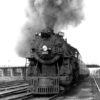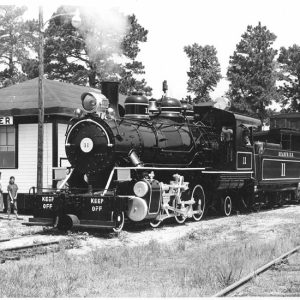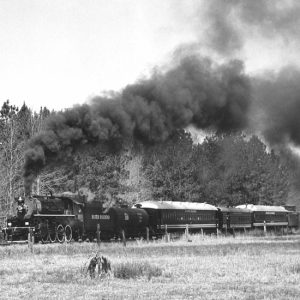calsfoundation@cals.org
Reader Railroad
The Reader Railroad, which ran through Nevada and Ouachita counties, was one of the last remaining trains drawn by steam locomotives. Though no longer in operation, either in industry or as a tourist attraction, it has drawn many to the area and was a featured set piece in the television miniseries, North & South.
Sayre Narrow Gauge, the railroad’s original name, was constructed in 1889 to move the virgin timber that was being harvested south of Reader, which is on the Nevada–Ouachita County border, for a sawmill at the St. Louis Iron Mountain & Southern Railroad located in Gurdon (Clark County). In 1910, the line was purchased by the McVay Lumber Company and, in 1913, was taken over by the Valley Lumber Company, which extended it to tracts of timber in lower Nevada County. A. S. Johnson purchased the sawmill company in 1921 and, in 1925, organized the Reader Railroad, named after the small community and postal stop of Reader, which was held under the parent company of Mansfield Hardwood Lumber Company, as a common carrier to transport freight to and from newly discovered oil fields near Waterloo (Nevada County).
Reader Railroad continued to work the river bottoms and creek valleys, hauling timber and freight until the mid 1950s, when the parent company was dissolved. Tom M. Long purchased the railroad and began an upgrade. He promoted the railroad for passenger and freight traffic, but the energy crisis of the early 1970s closed the refinery in Waterloo, and the lone freight and declining tourist traffic could not sustain the little railroad. Long abandoned his plans, and the railroad was sold to a group of businessmen in the area who worked to preserve it. They, in turn, sold it again in 1980 to the present owner, R. A Grigsby, who focused on emphasizing the history of Reader Railroad and the role it played in the development of south Arkansas.
As larger and more efficient equipment was built to harvest and transport the timber and oil, Reader Railroad became a tourist attraction. The railroad owns many refurbished cars, including two oil-burning locomotives built in 1907 and 1913, respectively, and one wood-burning locomotive built in 1907, as well as passenger cars, excursion cars, flatcars, boxcars, a tank car, and two stove-heated caboose cars.
The railroad was operated as it was seventy to eighty years ago. Running at only maximum speeds of twelve miles per hour, Reader Railroad took an estimated 100,000 people on rides through the forest, hills, and bottomlands of Nevada and Ouachita counties. At the end of the track, the engine was turned by hand on a turntable. The engine then picked up the train, while the caboose was placed on the rear for the return trip—a total of five and one-half miles, taking approximately two hours.
In 1985, ABC Television and Warner Brothers came to south Arkansas and used the railroad cars and station, enhanced by ABC, for the filming of train shots for the miniseries, North & South. Equipment from the Reader Railroad was also used in filming the 2007 movies 3:10 to Yuma and There Will Be Blood.
The railroad operated until 1991, when it could not meet the new federal safety regulations.
For additional information:
Early Prescott–Nevada Country History. Centennial Edition. N.p.: 1972.
Reader Railroad. http://www.readerrailroad.com/ (accessed June 2, 2021).
Debbie Fenwick Ponder
Camden, Arkansas
 Railroads
Railroads Transportation
Transportation Reader Railroad
Reader Railroad  Reader Railroad
Reader Railroad 




My grandfather, John Lawrence McGough II, was involved in the timber industry in the very late 1800s. I am researching to find more information regarding the family. I know he and his family were in Beekman, Morehouse Parish, LA, and he worked in the timber industry there. This was a small community built around the timber industry, I understand. It was sometimes the policy of the timber company to donate land and building materials for a church/cemetery in the area the timber industry was a great part of. That is the case of the old Methodist Church there and the cemetery in which my grandfather and his wife, Minnie Alice Sturdivant McGough, and their infant daughter, Minnie Margaret, are buried.